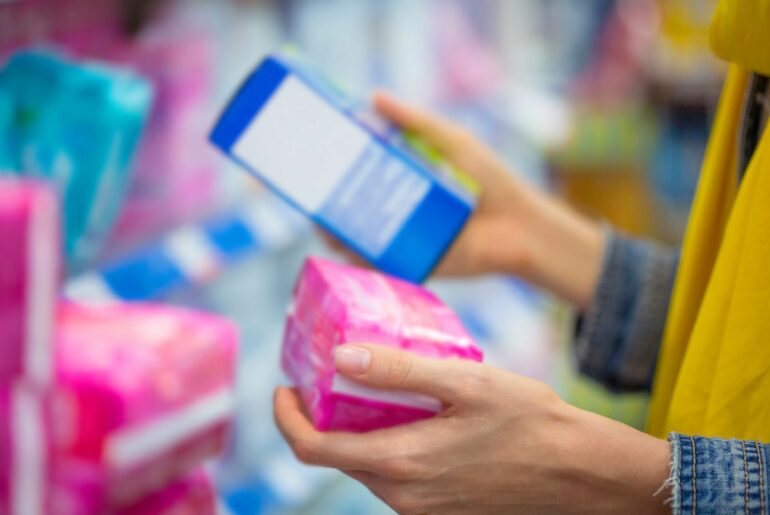About half of the population menstruates or will menstruate, but too many people lack the ability to manage their periods safely and with dignity. Pads and tampons are expensive, and an estimated 16.9 million people who menstruate in the U.S. are living in poverty. One in four young people have had to stay home from school due to lack of access to period products.
Many factors are to blame: overall poverty rates that disproportionately affect women, the rising costs and limited availability of period products, and policies such as state taxes on tampons and pads, all make menstrual hygiene supplies difficult or impossible to access for many families. In short, period products are treated as a consumer luxury, rather than a health necessity that anyone should be able to obtain.
But many advocates, including teens and legislators across the country, are working to increase access to period products and end “period poverty.”
The physical and mental health risks of “period poverty”
Not having access to enough tampons or pads during a period is not a mere inconvenience. It can come with increased health risks, including the rare but life-threatening toxic shock syndrome.
“People who are experiencing period poverty are either using things that are not meant for your period, or they’re using things that are meant for your period, but for too long … [which] causes everything from mild infections to upsetting fertility,” explained Wendi Schweigart, founder of the nonprofit organization Project Marilyn, which distributes period products to those in need in the Las Vegas area.
In addition, period poverty has a significant psychological impact. There’s the financial stress of having to choose between menstrual products and other necessities such as food. And then there’s the heightened anxiety produced by not having period products available on the day each period starts (which is often unpredictable, especially for adolescents).
Shame and humiliation, and a lack of confidence to go about everyday business, are major factors when you don’t have sufficient protection or access to a safe, clean bathroom to change tampons, pads, or other period supplies.
People experiencing heavy periods may carry even more of the financial and mental health burdens, as well as the health risks.
How period poverty affects students
From elementary school through college, students who menstruate face the stress and discomfort of having to manage their periods in school bathrooms. But those bathrooms are often void of any helpful products — instead, they sometimes have old, empty pad and tampon dispensers from decades ago. Often students have to go to the school nurse to find what they need, but that requires extra time and initiative, and permission from a teacher.
Pew Stateline reported that when Brooke and Breanna Bennett, 14-year-old twin sisters in Montgomery, Alabama, visited their mom at the school where she works, they noticed students going into their mom’s classroom to ask for pads and tampons. At the time, they didn’t understand why so many students didn’t bring their own menstrual supplies. But after learning about period poverty, they decided to start their own nonprofit initiative distributing hygiene kits with tampons, pads, and other toiletries to kids and families all over the city.
For students whose families can’t afford enough period products to make it through the school day or week — or for kids who are simply too embarrassed to ask for them due to societal stigma — this can lead to chronic absenteeism at school. Students are missing out on academic and extracurricular enrichment due to a lack of basic health supplies, and a lack of support from their community. Since periods typically occur for two to seven days every month, this pattern can be seriously detrimental to students’ lives and their futures.
Alleviating period poverty in schools
Some progress to combat period-product inequity for youth and students is being made, state by state. Recently, Hawaii became one of the latest states to pass a law requiring public schools to offer free period products to all students. Upon signing the law, Governor David Ige said, “No student should have their educational journey hampered because of lack of access to menstrual products.”
Other states have enacted similar measures. California and Alabama both have new laws that provide free period products to students at high-poverty middle schools and high schools. But in Alabama, the law comes with barriers: schools must apply for grants for the supplies, only female staff can distribute the products, and only female students can receive them (which denies access to some transgender and nonbinary students).
A new Illinois policy requires the state’s colleges and universities to supply free period products, while new Delaware legislation offers free menstrual hygiene products to youth in juvenile correctional facilities.
In Connecticut, state Rep. Kate Farrar pushed for a comprehensive law to provide free period products in schools, universities, and correctional facilities — and not only in the girls’ bathrooms.
Farrar said she was inspired by youth activists: “One of the student activists, her name is Joy … often captures it very well in saying, ‘You wouldn’t expect to have to pay for toilet paper when you went to the restroom, just as we shouldn’t expect to pay for a simple product required by our biology.’”







